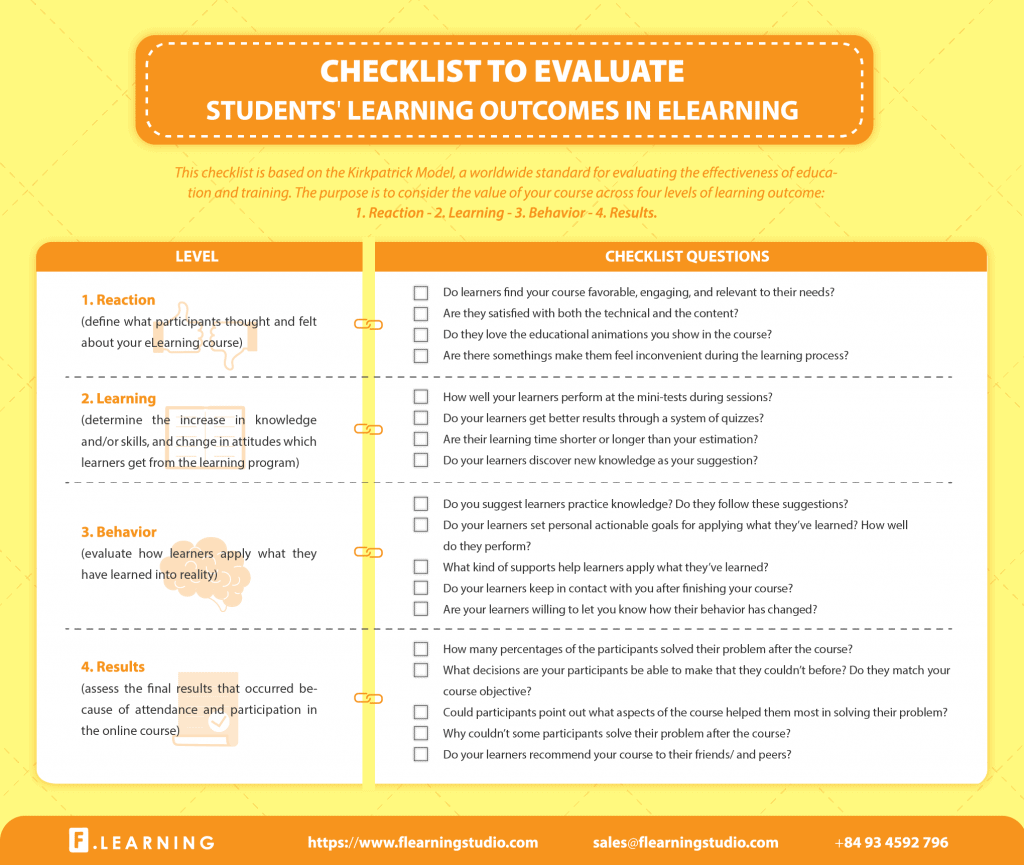At first glance, it may seem that evaluating online courses is not very complicated, especially since it is so flexible and online communication is so accessible. However, it is actually rather difficult to carry out good quality assessments. Despite this, online course evaluation is crucial to the improvement of future courses. Here are the three basic steps to it.
Step 1: Collect data on the course’s quality
The first step is to gather as much information as possible regarding the quality of your online course. What information about your course is worth collecting? Well, Quality Matters provide a rather detailed guideline on this.

According to this organization, the seven aspects listed above are what makes up a course. The quality of each adds to the overall quality of the course. For each aspect, the data collected can be slightly different – some can be number based, and some more opinion-based.
Quantitative data
Quantitative data is information that can be presented in terms of numbers. This information is easy to collect, often with the use of surveys. Besides, the analysis of this information is quite quick, especially with the help of digital tools and programs. It is also more efficient because learners are much more likely to rate things than to write a couple of sentences about them.
From the seven aspects listed by Quality Matters, quantitative data will be best for seeing how learners evaluate the course content, delivery and infrastructure. To do this, you can ask them to give each a mark out of five, for example. Other than that, the results of quizzes and tests can also demonstrate how well the course was delivered. Moreover, it shows whether the content of the online course is interesting enough for the learners to remember.
Qualitative data
This includes opinions and suggestions – written statements rather than numbers. These are more time-consuming to analyze and are difficult to collect. It’s because most people can’t be bothered to fill questionnaires out. Since there is no face-to-face pressure or connection in an online course, it’s even harder to make sure learners do respond.
The usefulness of this kind of data in online course evaluation is that it provides helpful insights. Here’s an example: you can find out specifically what about the course content or design was not good enough. You can also ask for suggestions to fix this that would suit learners.
Note: Have a balance!
It’s probably easier to collect numerical data, so gather plenty of that! However, don’t ignore qualitative data, and be ready to read into them. Having a balance of both kinds would make your online course evaluation a lot more valuable.
Tip: Make it short and lively
Whether it is a survey or questionnaire, try to ask around 10 questions! Otherwise, many people will think it’s time-consuming and will not want to complete it seriously. You can also add illustrations or nicely design it so that learners don’t get bored.
Step 2: Evaluate and analyze the data
For both quantitative and qualitative data, categorization is the key and first thing to do when analyzing. Here, Quality Matters also provide very detailed rubrics for different kinds of courses. We also have a checklist that you can consult when evaluating your students’ learning outcomes.

Categorization is key
Categorization helps you see related problems, and see which aspect needs work on the most. You can do first this by separating the data into aspects of the online course such as structure/design, content/material and interactions. By having these data groups, you will be able to see that maybe you have great content, but are struggling on designing an engaging course structure.
Another categorization is by the degree of effectiveness. This is where a rubric would really help. Create levels that reflect how good each aspect is (is it inadequate, adequate or excellent?). The effect of these levels is that you can more easily notice the overall feedback from all who responded to your survey. Then, you’ll be able to tell which aspect is more worrying and needs more attention.
Follow up and communicate
You may find some common trends in your feedback. For example, the majority of your learners say that some lessons and videos are too informative. Don’t be afraid to reach out and ask them to clarify what they mean by too much (is a 10-minute video too long?).
Here are some tips on using videos in eLearning that you might find useful:
Simple tips to create quality eLearning video lecture
Of course, like with qualitative data, it is unlikely that you will get a lot of response. But have faith in your learners, and understand that even if one person decides to seriously respond, it will be useful! Add these to your existing data to better help you find suitable solutions.
Step 3: Pick a course of action
All that analysis should point you towards a direction as to what to improve and maybe even how to improve your course. There is always room for improvement, so even if you get generally positive responses, don’t become idle! Similarly, getting bad responses doesn’t mean that there’s nothing you can do. The question is: equipped with all this information, what are you going to do? We have some suggestions for you!
Find solutions for each category
Part of the hard work is already done – you have already grouped and prioritized your problems in the previous step. Now, you only need to come up with a solution for each of them by order of that priority.
For example, your learners are not satisfied with your structure, and you have decided that it is the biggest problem. Consider applying the micro-learning structure to your course!
Maybe you want to find out more about online course structure:
Structuring your online course to encourage active learning
Otherwise, you may also consider adding more illustrations and animations to your course to make it more engaging and memorable. Do you know that visual learning is one of the most effective ways to take in new material? To add to that, visuals and animations are much more enjoyable to learners than a series of texts! Here’s an example of a short animation that we have produced that can be used in online courses.
You can find out more about educational animation here:
Animation’s role in creating a positive eLearning environment
Why you need animated infographics in eLearning
Learn from experts
Another option is to ask experts or look at their take on these problems. It is a lot easier to do this in this day an age when information is so widespread and readily available. You can email some experts without having to spend a lot of time, or you can look at blogs and websites of organizations such as Quality Matters to give you some ideas.
Be consistent!
The solutions that you come up with are not guaranteed to work. Thus, it is important to carry out online course evaluation frequently, to see if the alterations that you have made have positive effects. If your course is six months long, for example, send out surveys seven months after you’ve made your changes and learners have had the chance to experience them.
You should always check and see where you can improve!
Conclusion
Those are the three basic steps to online course evaluation: data collection, data analysis and finding solutions. The important things to remember are:
- Collect a balance of quantitative and qualitative data
- Categorize your information when analyzing
- Be flexible and open to continual improvement
If you can successfully evaluate your course, you will be able to make it better for your learners! To help you some more in this evaluating and revising process, we have some more tips and advice below. Go check them out!
Read further:
- What do you need to develop a successful eLearning course?
- 4 criteria of a great content course in eLearning
- 5 tips for instructional graphic design: make your course beautiful
- 3 visual problems that educators should avoid in eLearning

Sean Bui, the founder and creative director of F.Learning Studio, is a respected leader in the e-learning and multimedia production industry. With over 10 years of experience, he has dedicated his career to helping organizations create engaging and impactful learning experiences.
Under his leadership, F.Learning Studio has grown into a trusted partner for organizations in the education, healthcare, and corporate training sectors, producing over 2,000 minutes of educational animation.




